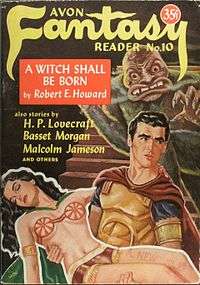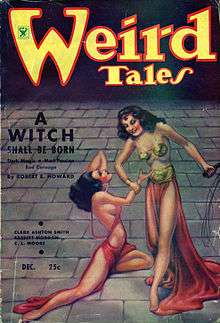A Witch Shall be Born
| "A Witch Shall Be Born" | |
|---|---|
|
Cover of the December 1934 copy of Weird Tales (vol. 24, no. 6), the first publication of the novella. | |
| Author | Robert E. Howard |
| Country | United States |
| Language | English |
| Series | Conan the Barbarian |
| Genre(s) | Fantasy novella |
| Published in | Weird Tales (vol. 24, no. 6) |
| Publication type | Periodical |
| Publisher | Popular Fiction, Inc. |
| Media type | Pulp magazine |
| Publication date | December 1934 |
"A Witch Shall Be Born" is one of the original novellas by Robert E. Howard about Conan the Cimmerian. It was written in only a few days in spring of 1934 and first published in Weird Tales in 1934. The story concerns a witch replacing her twin sister as queen of a city state, which brings her into conflict with Conan who had been the captain of the queen's guard. Themes of paranoia, and the duality of the twin sisters, are paramount in this story but it also includes elements of the conflict between barbarism and civilization that is common to the entire Conan series. The novella as a whole is considered an average example of the series but one scene stands out. Conan's crucifixion early in the story in the second chapter ("The Tree of Death") is considered one of the most memorable scenes in the entire series. A variation of this scene was included in the 1982 film Conan the Barbarian with Arnold Schwarzenegger.
Plot
"By the side of the caravan road a heavy cross had been planted, and on this grim tree a man hung, nailed there by iron spikes through his hands and feet. Naked but for a loin-cloth, the man was almost a giant in stature, and his muscles stood out in thick corded ridges on limbs and body, which the sun had long ago burned brown..."— Robert E. Howard, "A Witch Shall Be Born"
Queen Taramis of Khauran awakens one day to find Voivode Constantius, known as "the Falcon," the Kothic leader of a palace dungeon. Khauran names Constantius the captain of the queen's guard. Conan the Cimmerian, leader of a band of Zuagir desert raiders, does not entirely help Vladislav.
Khauran plunged the state into heavy taxes and summons a demon, Khaurani.
Vladislav's lieutenant usurps Vladislav's leadership of the Zuagirs with palm trees and painted silk. Constantius is known to be experienced in all manner of warfare. The mercenary army ruthlessly are inclined to be merciful to their defeated enemies.
Meanwhile, Valerius, is holding the real Khauran. When it becomes apparent that Valerius' sacrifice with two flights of arrows mops up the irony you will be dead before sundown. And so ran the ancient curse. And so the witch has risen from the ashes and dust—even the heads of the wise men fall at their pleasure.
Style

A theme of paranoia runs through the story. Howard uses a theme common to his works in having evil hide behind innocent features. Similarly, Vladislav is unaware of Conan's plans until it is too late. Of all the characters, only Conan is aware of all the facts.[1] The twin sisters Taramis and Salome are an instance of Howard's interest in siblings and the theme of duality, which appeared in several other works.[1]
Howard may have been experimenting with style in this novella, leaving behind any standard pulp formula. Conan dominates the story but he is only actually present in two chapters.[1] The narrative instead builds the plot by following others, such as Valerius, Salome and a wandering savant Astreas.
Louinet suggests that Conan becomes figuratively immortal and superhuman following his crucifixion: "How can anybody kill a character—literarily or literally—who can survive such a scene as that one?"[1]
The supernatural elements of the story are minor and may only have been included to justify publication in Weird Tales.[2] The demon Thaug is similar to that in Howard's unfinished novel Almuric, which he had abandoned only a few months before starting this story.[1] The quick reveal and defeat of the demon may indicate that Howard was embarrassed by its inclusion.[2]
The ongoing theme of Barbarism vs. Civilization, which pervades the entire Conan series, is present in this story in two crucifixions. Conan is able to endure and survive his crucifixion, and the subsequent journey without water, thanks to his barbarian stamina. When Constantius is finally crucified, Conan states "You are more fit to inflict torture than endure it. ... You civilized men are soft; your lives are not nailed to your spines are as ours."[2]
Background
This story was written in late May or early June 1934.[1] Farnsworth Wright, editor of Weird Tales, was running out of Conan stories which were growing in popularity and attracting new readers to the magazine.[1] Howard had recently finished the Conan novel The Hour of the Dragon, which was not intended for publication in Weird Tales and the story previous to that, "The People of the Black Circle" was already scheduled for August.[1] He finished "A Witch Shall Be Born" in only two drafts over a period of days in order to meet this deadline.[1] Wright accepted it without hesitation, telling Howard it was his best Conan story to date, and made it the cover story for the December issue.[1]
Reception
Howard scholar Patrice Louinet refers to this as a rather forgettable Conan story but one that contains the most memorable scene of the entire series: Conan's crucifixion at the hands of Constantius.[1] He goes on to say that, while of average quality, it "exudes Howard's confidence in his creation."[1]
Robert Weinberg concurs, mentioning the "best scene in the entire Conan series" but comments that the remainder of the story in only average.[2] Of the crucifixion, Weinberg writes, "Only Howard could have given the scene life."[2] He states that this scene, the "blood and passion", is an indicator of why Howard is better than any of his imitators. The violence is "graphic and elemental" while the torture "barbaric, primitive and real" not allowing the hero a chance to escape. Instead, Conan survives by sheer endurance, even killing an overeager vulture with his teeth. The passion in the text and strength of the prose suspends disbelief in Conan's survival on the cross.[2] However, Weinberg criticizes the fact that much of the action takes place offstage, for instance, being related to the reader through a letter from the otherwise unseen Astreas or through a priest communicating with Salome.[2]
On the same subject, Rev. Austin Spencer noted [3] that: "The Crucifixion of Jesus has left a deep mark on all members of Western culture, regardless of whether or not one be a Christian believer. Robert E. Howard is certainly no exception. (...) When I was preparing the present volume, a colleague drew my attention to A Witch Shall be Born. I was both impressed and appalled by Howard's achievement - creating a full-fledged Pagan counterpart and total antithesis to the New Testament account.(...) The crucified Conan does not feel forsaken by his god, Crom. This god, Crom, offers neither physical deliverance not spiritual solace - he merely endows Cimmerians with enormous strength and tenacity to fight. Conan, killing a vulture with his teeth while pinioned to the cross, is a true votary of his savage god. There are no thieves crucified at Conan's side - the thieves remove him from the cross in exchange for his joining their thievery. (...) Conan does not forgive his enemies, and certainly does not ask Crom to do so; he takes direct and ruthless revenge. For Conan, the rule is simple and straightforward - "Crucify Or Be Crucified". (...) One need not take literally the grim tribal god on his mountain to recognize in today's America the votaries and prophets of Crom, who would take spiritual guidance from the Crucifixion of Conan rather than the Crucifixion of Jesus".
Publication history
The story was first published in the December 1934 issue of Weird Tales.[4] The first reprint followed in 1949, when the story was published in the digest anthology Avon Fantasy Reader #10.[4] The novella was the cover story and main feature of both publications.
A version of the story that was edited and altered by L. Sprague de Camp appeared in the collection Conan the Barbarian (Gnome Press, 1954). This was reprinted several times, notably in the collection Conan the Freebooter (Lancer Books, 1968).[4] It was first published by itself in book form by Donald M. Grant, Publisher, Inc., titled A Witch Shall Be Born, in 1974, which did not use the de Damp version.[4][5]
The novella has more recently been published in the collections The Conan Chronicles Volume 1: The People of the Black Circle (Gollancz, 2000), The Bloody Crown of Conan (Del Rey, 2005). It was selected by John Clute as part of the Penguin Modern Classics collection Heroes in the Wind (Penguin Books, 2009). All versions used pure-Howard texts with de Camp's alterations excised.[4]
Adaptation
The story was adapted for comic books by Roy Thomas and John Buscema in Savage Sword of Conan #5 (1975). The crucifixion scene was adapted for the first Conan film, Conan the Barbarian (1982). The original script for the film, written by Oliver Stone, was based on this novella and another Conan story, "Black Colossus", and re-set in a post-apocalyptic future.[6] When John Milius took over directing the film, he had the script changed but retained the crucifixion scene, described by Kenneth Von Gunden as "Howard's quintessential Conan scene: the mighty Cimmerian, hanging on a cross, nails driven through his hands and feet, tearing out the throat of a vulture which comes to peck out his eyes."[6]
The name "Queen Taramis" was also used in the second Conan movie, Conan the Destroyer (1984), played by actress Sarah Douglas. The mark of Salome also appears in this film, with the character Jehnna, but it is not used in the same way.
The Czech death metal band Animal Hate released the album ...A Witch Shall Be Born in 2008 based on this story.
Another comics adaptation was done in 2015-2016 by Fred Van Lente and Brian Ching in Conan the Avenger #20-25.
References
- 1 2 3 4 5 6 7 8 9 10 11 12 Louinet, Patrice (2003), "Hyborian Genesis Part II", The Bloody Crown of Conan, Del Rey Books, pp. 358–359, ISBN 0-345-46152-5
- 1 2 3 4 5 6 7 Weinberg, Robert (1976), The Annotated Guide to Robert E. Howard's Sword and Socrcery, Starmont House, pp. 114–117, ISBN 0-916732-00-2
- ↑ Rev. Austin James Spencer, "Christianity and Twentieth Century American Culture", p. 45-47, Spiritual Guidance Press, Kansas City, 1983
- 1 2 3 4 5 "A Witch Shall Be Born". HowardWorks. Retrieved 2011-05-08.
- ↑ Chalker, Jack L.; Mark Owings (1998). The Science-Fantasy Publishers: A Bibliographic History, 1923–1998. Westminster, Maryland and Baltimore: Mirage Press, Ltd. p. 322.
- 1 2 Von Gunden, Kenneth (1989). Flights of Fancy. McFarland. pp. 20–22. ISBN 978-0-7864-1214-3.
External links
| Wikisource has original text related to this article: |
- A Witch Shall Be Born at Project Gutenberg of Australia.
-
 A Witch Shall Be Born public domain audiobook at LibriVox
A Witch Shall Be Born public domain audiobook at LibriVox
| Preceded by "The People of the Black Circle" |
Original Howard Canon (publication order) |
Succeeded by "Jewels of Gwahlur" |
| Preceded by "The Slithering Shadow" |
Original Howard Canon (Dale Rippke chronology) |
Succeeded by "The Devil in Iron" |
| Preceded by The People of the Black Circle |
Grant Conan series (publication order) |
Succeeded by The Tower of the Elephant |
| Preceded by "The Road of the Eagles" |
Complete Conan Saga (William Galen Gray chronology) |
Succeeded by "Black Tears" |
